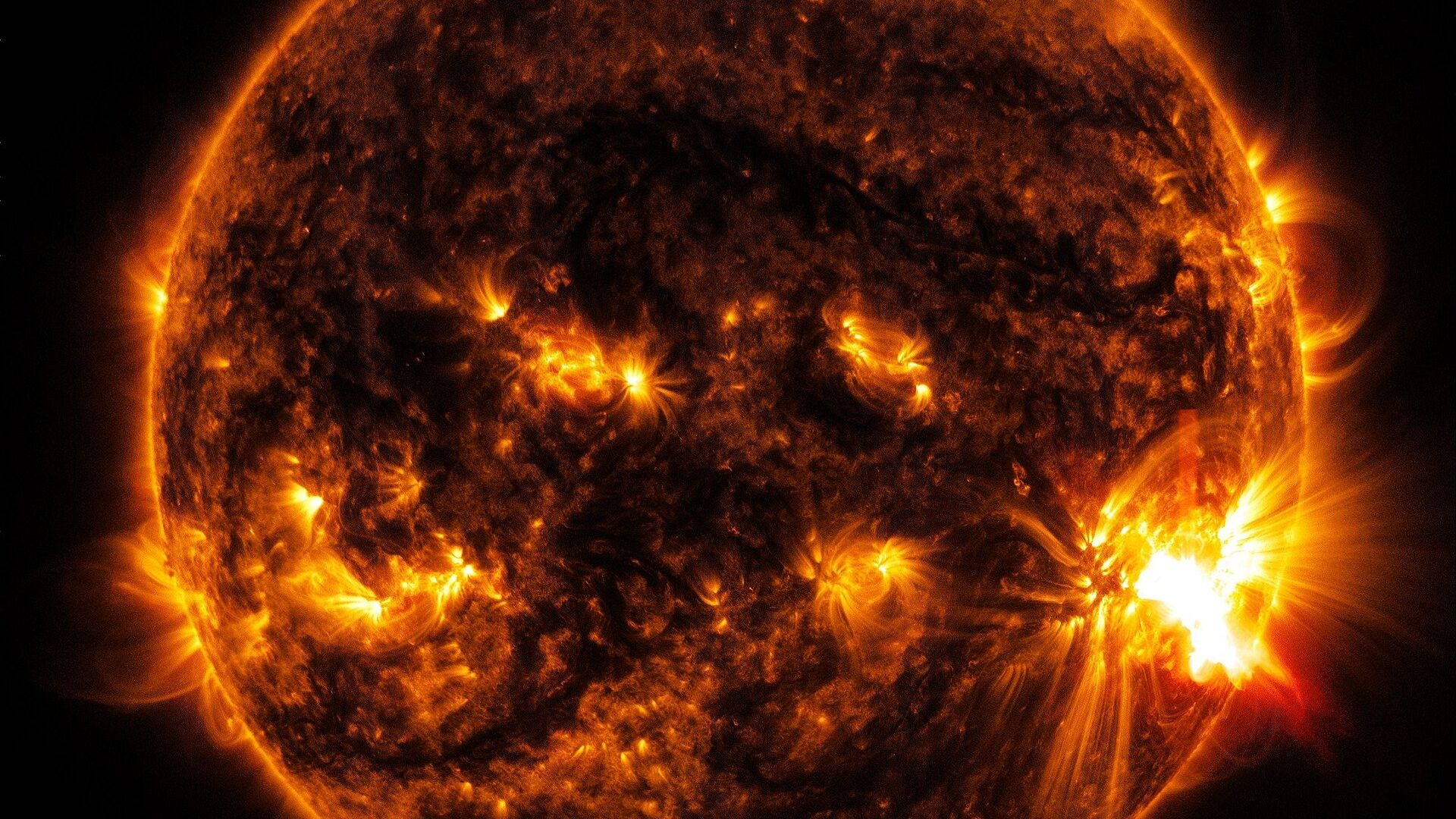https://sputnikglobe.com/20240216/solar-flare-fourth-strongest-in-five-years-detected-on-sun-1116821461.html
Solar Flare 'Fourth Strongest' in Five Years Detected on Sun
Solar Flare 'Fourth Strongest' in Five Years Detected on Sun
Sputnik International
A solar emission from active zone 3576, following a previous X3.3 flare, marks a rare occurrence of repeated high-powered eruptions within a solar cycle.
2024-02-16T15:06+0000
2024-02-16T15:06+0000
2024-02-16T15:06+0000
russia
science & tech
moscow
earth
institute of space research
russian academy of sciences (ras)
https://cdn1.img.sputnikglobe.com/img/105834/48/1058344899_0:420:1920:1500_1920x0_80_0_0_2da0abb10c88f267df996fa8000b6036.jpg
A powerful solar flare of the highest magnitude class X occurred on the Sun on Friday at 12:52 pm GMT.The Laboratory of Solar Astronomy of the Institute of Space Research of the Russian Academy of Science reported the event on its website.According to the laboratory, the event occurred on the periphery of the solar surface, away from the Sun-Earth axis. There is the possibility that high-speed charged particles emitted by the flare could affect spacecraft. However, the likelihood of magnetic storms and auroras occurring is below five percent.The solar flare burst out from active zone 3576, where an earlier top-score flare of X3.3 was detected a couple of days earlier. That was the first time one region of the sun generated two higher-powered outbursts within a solar cycle.The most powerful flare recorded in 5 years remains the New Year's event on January 1, 2024, reaching an X5.0 intensity.Solar flares are classified into five grades: A, B, C, M, and X, according to the intensity of their X-ray emission.Researchers had earlier recorded a rise in the frequency and intensity of solar flares, indicating that the Sun is steadily nearing its height of activity. That peak is expected as soon as mid-year, though some predictions suggest it may be delayed until 2025.Solar flares can cause magnetic storms on our planet, disrupting energy infrastructure and altering the migratory paths of bird and animal species.
https://sputnikglobe.com/20230331/dark-side-of-sun-x-class-solar-flare-rocks-earth-and-blackouts-radio-1108982946.html
moscow
earth
Sputnik International
feedback@sputniknews.com
+74956456601
MIA „Rossiya Segodnya“
2024
Chimauchem Nwosu
https://cdn1.img.sputnikglobe.com/img/07e7/09/01/1113046371_0:99:1536:1635_100x100_80_0_0_9c5c627283eca931c39fe4852bbb301c.jpg
Chimauchem Nwosu
https://cdn1.img.sputnikglobe.com/img/07e7/09/01/1113046371_0:99:1536:1635_100x100_80_0_0_9c5c627283eca931c39fe4852bbb301c.jpg
News
en_EN
Sputnik International
feedback@sputniknews.com
+74956456601
MIA „Rossiya Segodnya“
Sputnik International
feedback@sputniknews.com
+74956456601
MIA „Rossiya Segodnya“
Chimauchem Nwosu
https://cdn1.img.sputnikglobe.com/img/07e7/09/01/1113046371_0:99:1536:1635_100x100_80_0_0_9c5c627283eca931c39fe4852bbb301c.jpg
solar emissions, solar flares, auroras, magnetic storms, laboratory of solar astronomy of the institute of space research of the russian academy of sciences, x-ray emission, intensity of solar flares.
solar emissions, solar flares, auroras, magnetic storms, laboratory of solar astronomy of the institute of space research of the russian academy of sciences, x-ray emission, intensity of solar flares.
Solar Flare 'Fourth Strongest' in Five Years Detected on Sun
A solar emission from active zone 3576, following a previous X3.3 flare, marks a rare occurrence of repeated high-powered eruptions within a solar cycle.
A powerful
solar flare of the highest magnitude class X occurred on the Sun on Friday at 12:52 pm GMT.
The Laboratory of Solar Astronomy of the Institute of Space Research of the Russian Academy of Science reported the event on its
website.
"The event is classified as X2.6, which means it is the fourth strongest event in the last five years, according to the catalogs...The likelihood of the outbreak impacting Earth is currently assessed as extremely low," the lab's statement read.
According to the laboratory, the event occurred on the periphery of the solar surface, away from the Sun-Earth axis. There is the possibility that high-speed charged particles emitted by the flare could affect spacecraft. However, the likelihood of magnetic storms and
auroras occurring is below five percent.
The solar flare burst out from active zone 3576, where an earlier top-score flare of X3.3 was detected a couple of days earlier. That was the first time one region of the sun generated two higher-powered outbursts within a solar cycle.
The most powerful flare recorded in 5 years remains the New Year's event on January 1, 2024, reaching an X5.0 intensity.
Solar flares are classified into five grades: A, B, C, M, and X, according to the intensity of their X-ray emission.
Researchers had earlier recorded a rise in the frequency and intensity of solar flares, indicating that the Sun is steadily nearing its height of activity. That peak is expected as soon as mid-year, though some predictions suggest it may be delayed until 2025.
Solar flares can cause
magnetic storms on our planet, disrupting energy infrastructure and altering the migratory paths of bird and animal species.




